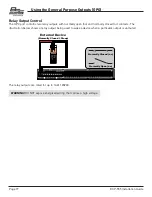
Page 12
DCP-555 Installation Guide
Using BLU Link
Connecting to the Web-Server App
To connect to the DCP-555's built-in web-server app and begin configuring the device:
1� With the control device connected to the same network as the DCP-555, launch the browser of choice and
enter the DCP-555's IP address in to the browser's address field�
2� Enter
administrator
for the password and then select
SignIn
�
3� Once logged in, you can change the password by clicking the
User
icon
in the upper right-hand corner
of the window�
See the DCP-555 control app help for information on configuring the DCP-555�
Using BLU Link
BLU link is a proprietary point-to-point digital audio bus that supports up to 256 audio channels at 48kHz or
128 audio channels at 96kHz� The DCP-555 supports 28x32 channels of BLU link audio at 48kHz�
NOTE: The BLU link sample rate for all devices on a BLU link bus must be configured to match� The DCP-555
has a fixed sample rate of 48kHz, so all other BLU link devices connected to the bus must also be configured
for 48kHz operation�
Making BLU Link Connections
The physical BLU link connections are made using Category 5e or higher cabling connected from the BLU
link OUT port of one device to the BLU link IN port of another device� Additional devices should be connected
in a daisy-chain topology� Redundancy can be provided by completing the loop and connecting the BLU link
OUT port from the last device to the BLU link IN port of the first device� The maximum cable length between
devices cannot exceed 100m/328ft� The BLU link audio bus supports a maximum of 60 BLU link nodes�
NOTE: DO NOT connect BLU link ports to network peripherals, such as a network hub, switch, or router�
Since BLU link is not an AoIP protocol, such devices are not supported and BLU link audio will not pass
through them�
Fault Tolerance
When the last BLU link device in a system is connected back to the first, the BLU link bus is capable of a
degree of fault tolerance since each device receives the same audio from two other devices� If a single cable
connection is broken, the devices which are no longer connected will detect the cable break: one device will
detect that its BLU link IN port is disconnected and the other will detect that its OUT port is disconnected� The
devices will then re-route the audio so that it can again pass through the bus�
NOTE: When the cable is broken, the audio will take longer to reach its destination� This small added delay
is not compensated for in any way, but is a side-effect of the way the fault tolerance system functions�
























